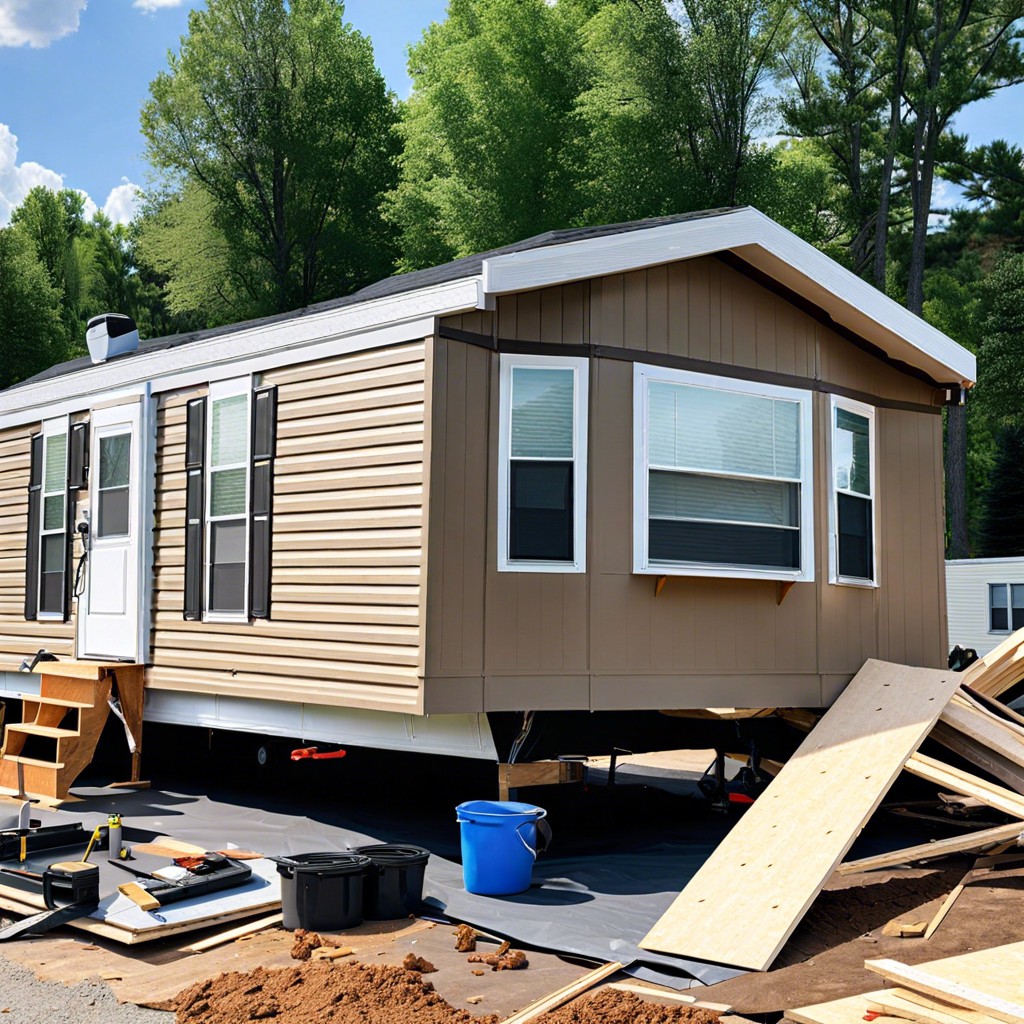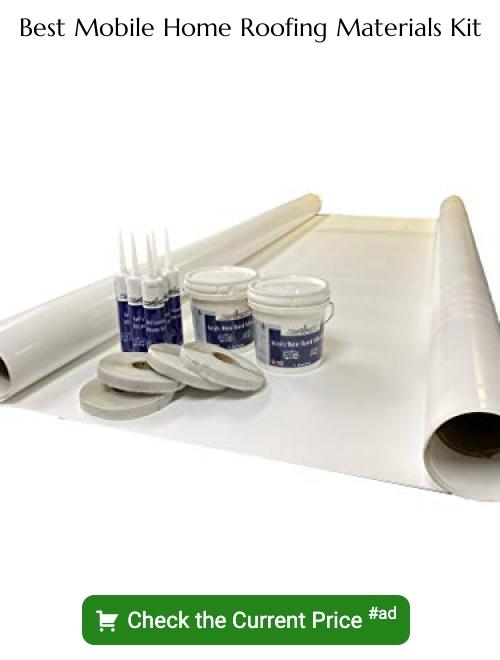Last updated on
Unveiling the considerable factors, this blog dives into the cost implications associated with mobile home roof replacement.
Key takeaways:
- Mobile home roof replacement costs range from ,500 to ,600 (single-wide) and ,000 to ,000 (double-wide).
- Material choices, labor costs, roof features, and disposal impact the cost.
- Factors affecting costs include size, material choice, location, roof condition, and complexity.
- Common manufactured home roof materials are metal, asphalt shingles, and rubber.
- When getting estimates, research credentials, request detailed proposals, clarify materials and workmanship, and consider additional costs and negotiation.
$1,500 – $9,600 Average Cost to Replace Roof (single-wide)

For a single-wide mobile home, roof replacement typically ranges from $1,500 to $9,600. This cost variation is due to different materials used and labor fees which can vary widely by region and contractor.
On the lower end, materials like rolled roofing are cost-effective and suitable for flatter roof profiles. Mid-range options often include shingles or metal roofing, offering a balance of durability and cost. High-end materials like standing seam metal roofs account for the upper cost tier, reflecting their longevity and energy efficiency.
It’s essential to consider the roof’s size, pitch, and the potential need for additional repairs when budgeting for this crucial maintenance.
$3,000 – $16,000 Average Cost to Replace Roof (double-wide)
The price range for a double-wide mobile home roof replacement can be broad due to various contributing factors. Material choices such as metal, rubber, or asphalt shingles each come with different price tags. For instance, metal roofs, while more costly upfront, provide longevity and durability.
Labor costs also play a significant role and can vary substantially depending on location, the complexity of the installation, and the current market rates for professional roofing contractors.
Roof features, including pitch and size, fundamentally impact overall expenses. A steeper pitch requires more safety measures, hence increasing labor costs, while a larger surface area necessitates more materials.
Finally, the removal and disposal of the existing roof can affect the total cost. If the old materials are particularly heavy or require special handling, disposal costs may be higher.
Considering these aspects helps homeowners navigate the cost spectrum for a double-wide mobile home roof replacement.
Factors That Affect Roof Replacement Costs
The size of your mobile home plays a significant role in determining the overall cost. A larger footprint necessitates more materials and labor.
Roofing material choice is next in line of impact; standard options include metal, rubber, and asphalt shingles, each with varying price points and longevity.
Geographic location can sway prices due to local labor costs and availability of materials.
The current condition of your roof also drives the price—extensive damage may require additional repairs before a full replacement can be carried out.
Moreover, the complexity of the roof design, with factors such as pitch and the presence of skylights or chimneys, can complicate the replacement process, potentially increasing labor hours.
Lastly, prices can fluctuate based on market conditions and seasonal demand; it’s often more expensive during peak roofing seasons.
Types of Manufactured Home Roofing
Mobile homes typically feature three main types of roofing materials:
1. Metal Roofing: A common choice offering durability and a lifespan of up to 50 years. Metal roofs can come in large panels or shingles and vary in quality and price. They are particularly resistant to harsh weather conditions.
2. Asphalt Shingles: These are widely used due to their cost-effectiveness and ease of installation. They have an estimated lifespan of 15 to 30 years and offer a traditional look for mobile homes. Asphalt shingles come in various styles and colors to match different aesthetics.
3. Rubber Roofing (TPO or EPDM): Rubber roofing is known for its ability to handle extreme temperatures and resist water leaks. TPO (Thermoplastic Olefin) and EPDM (Ethylene Propylene Diene Monomer) are two types of rubber roofing materials that are lightweight, recyclable, and typically white, reflecting sunlight to help reduce cooling costs.
Selecting the right material involves considering factors such as climate, maintenance requirements, and aesthetic preferences. Upgrading the roofing material can also improve the home’s insulation and energy efficiency.
Getting Estimates From Mobile Home Roofing Companies
Requesting multiple estimates from licensed roofing companies is a pivotal step in the roof replacement process for a mobile home. Here are key points to consider when seeking quotes:
1. Research Credentials: Ensure the contractors are licensed, insured, and have a good track record. Check online reviews and the Better Business Bureau for their reputation.
2. Detailed Proposals: Each estimate should include a breakdown of materials, labor costs, timeline, disposal fees, and warranty information. This will allow for accurate comparison between different contractors.
3. Materials and Workmanship: Clarify the type of roofing materials and the quality of workmanship offered. Higher-grade materials and experienced labor might be more costly but can lead to longer-lasting results.
4. Inspection: Most contractors will perform a free inspection to assess the condition of the current roof and provide a more accurate quote. Make sure the inspection covers potential structural issues that might influence cost.
5. Additional Costs: Be aware of potential added costs such as site preparation, permits, and any necessary repairs to the roofing structure that may not be included in the initial quote.
6. Negotiation: Use the estimates as a bargaining tool. Some contractors might be willing to match or beat their competitors’ pricing if you show them other lower estimates.
7. Payment Plan: Inquire about payment options. Some companies offer financing, which can be helpful if an immediate, full payment is not feasible.
By gathering and evaluating this information, homeowners can make an informed financial decision regarding their mobile home roof replacement.
FAQ
What kind of roof is best for a mobile home?
The most recommended types of roofing for mobile homes are shingle and metal, though rubber, liquid, and TPO roofing are also available options.
Is it worth it putting a metal roof on a mobile home?
Yes, it is worth putting a metal roof on a mobile home as it adds durability, providing effective protection against various weather conditions such as rain, snow, UV rays, hail, and high-speed winds.
How long should a mobile home roof last?
A mobile home roof, particularly one with asphalt roofing, can typically last between 15 to 30 years.
What are older mobile home roofs made of?
Older mobile homes, specifically those constructed prior to June 1976, typically have roofs made from sheet metal or asphalt coating.
How does the size of a mobile home impact the overall roof replacement cost?
The size of a mobile home directly impacts the overall roof replacement cost, as larger homes require more materials and labor, thereby escalating the cost.
What are the typical maintenance needs for different types of mobile home roofs?
Typical maintenance for mobile home roofs includes routine inspections for leaks, proper drainage, structural soundness, particularly in metal and asphalt roofs, and checking rubber roofs for cracks or tears which must be sealed immediately.
Can solar panels be safely installed on mobile home roofs, and if so, does this affect the durability of the roof structure?
Yes, solar panels can be safely installed on mobile home roofs, but care must be taken to ensure that the roof structure is strong enough to bear the additional weight to maintain its durability.





